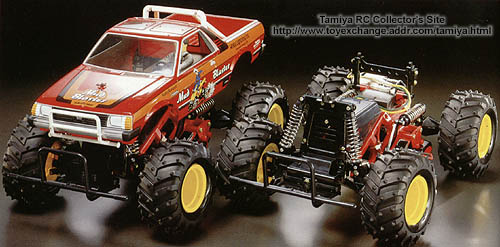Analysis of individual cars
The Mudblaster (58077)

The Mudblaster was kit number 77 from Tamiya. A 1/10 2WD, off-road monster truck, this kit was based on the Blackfoot chassis
Specifications
- 1/10 scale off-road vehicle
- 2 wheel drive (rear drive with half shafts)
- Plastic frame chassis design
- Independent rear drive with trailing arm suspension
- 4 coil spring shocks (non-damped)
- RS-540 Mabuchi motor
- Realistic oversized pin spike monster tires
- ABS plastic body
Description
The MudBlaster was released to capitalize on the Monster Truck craze that was sweeping across North America at the time. The kit was relatively inexpensive for Tamiya to make as it was based on the recently released Blackfoot, which in turn was a derivative of the Frog chassis.
Based on the sturdy Frog chassis, the truck featured a fully independent suspension all the way around. The front suspension arms and steering mechanism were beefed up to handle the forces incurred by having to drive the much larger (and heavier) tires.
In the rear, the mounting points for the shocks were modified to handle the longer shocks and also greater forces induced by the new monster tires. A cover was introduced to better protect the radio gear and speed control from the elements. A much better solution than the rubber balloon used on the Frog.
The rear drivetrain was taken directly from the Frog with no changes. Everything from the gearbox to the drive shafts were lifted directly from the older car. The body chosen for the MudBlaster was the Subaru Brat, a molding that was originally released some years before as kit 38 (Subaru Brat).
Tamiya had to do very little to get this kit out the door. The chassis was identical to the Blackfoot (save a slight change to the rear mounting posts) and the body was the same as one released a few years ago. All that was needed was a new decal set, instruction manual and box. This trend of redeploying chassis's and body kits would be a business strategy that would serve Tamiya well. It allowed the company to introduce unique and sometimes limited edition kits without having to invest in costly retooling. As an added advantage, third party companies already had a suite of performance parts for the car. Thorp, Hot Trick and CRP were just a few of the companies that came out with performance parts originally for the Blackfoot and now could be applied to the Mud Blaster.
Not surprising, the car drove like the Blackfoot. The standard coil springs allowed for a lot of bounce and rough off-road tracks tended to toss the car around quite a bit. On pavement though, it was really neat to see the rear end hunch down when power was applied. Owners quickly discovered that the pin spikes on the tires didn't last long on pavement. No more than 2 or 3 battery packs was required to wear them down.
Historical Significance
The Mud Blaster was never that popular in North America. I suspect because the Subaru Brat itself never was a popular vehicle here. Having said that, the car itself has held its value well because of its similarities to the Blackfoot. New in box kits will still cost about $225 to $275 under heavy bidding.
Collectors may also be interested in purchasing the kit to complete a run of this chassis. But given the choice between this kit and the Blackfoot or Monster Beetle; the other two will win hands down. The Blackfoot, because it was the first to use this new chassis, and the Monster Beetle because of the cross-over interest with Volkswagen enthusiasts.
Additional Notes
The Mud Blaster carried the same weak points as the Blackfoot and the Monster Beetle. First was the rear drivetrain. The gearbox suffered from "separation slippage" where the gearbox halves would spread apart under torque and cause the bevel gears to slip and chatter. This was a problem with the Frog and the high loads imposed by the Mudblaster’s large tires only aggravated it. Thorp’s aftermarket ball-diff and dog bone kit was very popular amongst Mud Blaster owners.
Other weak points include the rear suspension mounts, front bumper and mounts, and slop in the front suspension. All of these were addressed with aftermarket parts, but for the purist it’s important to check on the condition of the original pieces.
The bodies on these trucks tend to take a lot of abuse so check for stress fractures by the mounting points, condition of the front and rear windscreen and chrome trim pieces.
Rating
- Collectibility – 6 out of 10
- Fun to drive – 7 out of 10
- Parts availability – 7 out of 10
